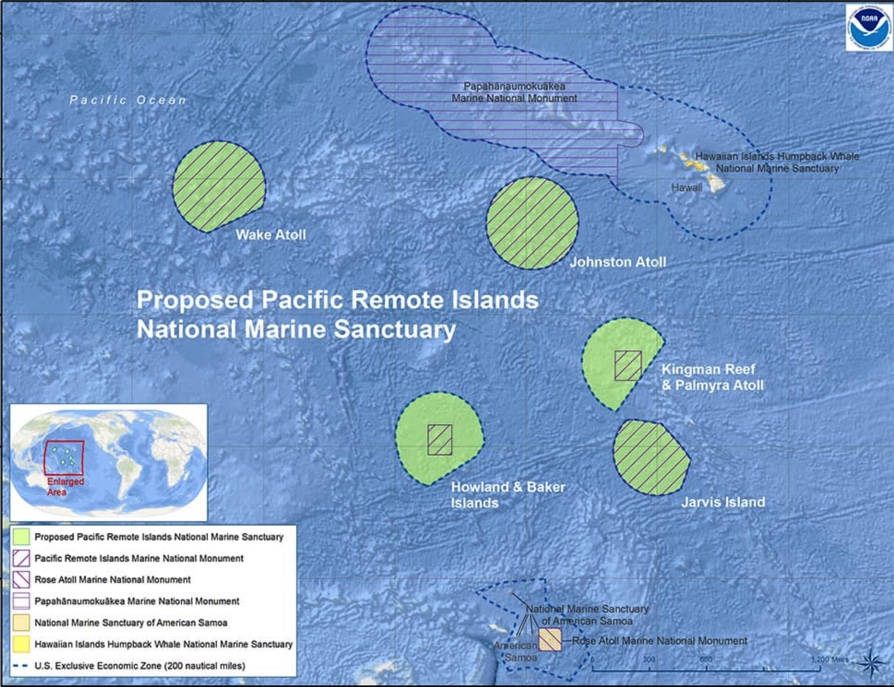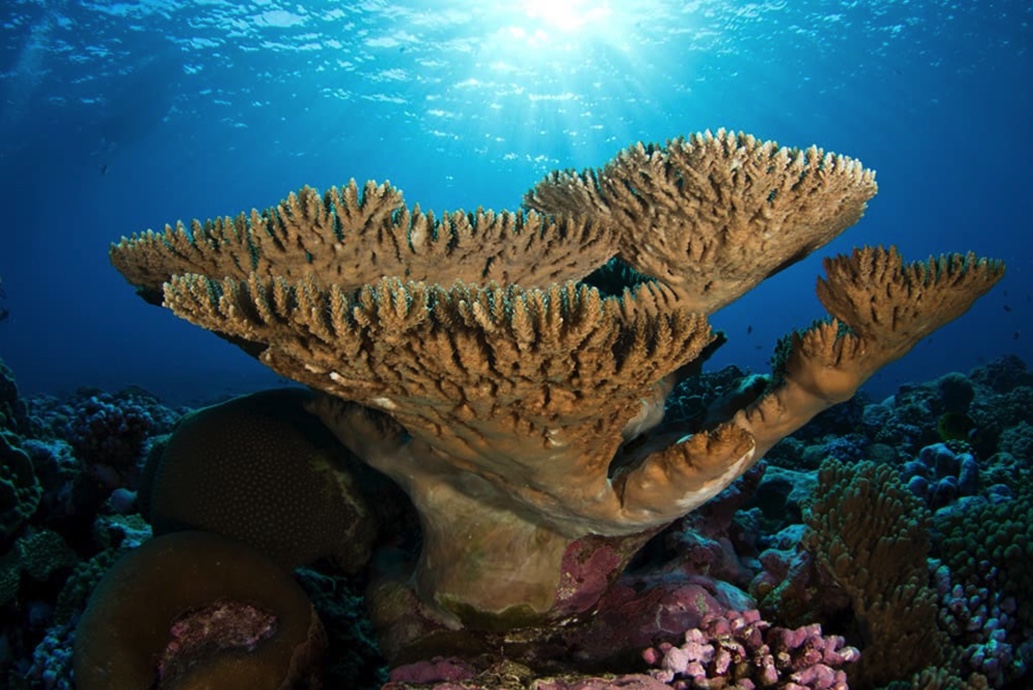Above photo: Acropora corals grow toward the sunlight to form beautiful, massive tables at Palmyra Atoll. CREDIT: JEFF MILISER/NOAA.
The National Oceanic and Atmospheric Administration has begun the environmental scoping process for a proposal to establish a national marine sanctuary surrounding the Pacific Remote Islands. The proposal would extend sanctuary waters from the fast land out to the 200-mile limit of the U.S. Exclusive Economic Zone. At present, the Pacific Remote Islands National Marine Monument extends 50 miles offshore.
The Pacific Remote Islands Coalition, which has for years been pushing for the sanctuary, submitted a formal nomination to NOAA on March 11. On March 24, President Joe Biden directed NOAA to consider it for designation.
In the nomination, the coalition cites more than the need to protect the natural resources of the area. It points to the region’s “storied history, beginning with Pacific Island cultures – Native Hawaiians, Chamorro, and other Indigenous Peoples – who voyaged across the Central and Western Pacific interpreting the stars, winds, and currents to exercise a wayfinding proficiency that allowed for the vastness of the largest ocean on Earth to become a shared home.”
It also celebrates “the bravery and sacrifice of the Hui Panalāʻau – a group of 130 young men, mostly Native Hawaiian, who voluntarily occupied the islands of Jarvis, Baker, and Howland, from 1935 to 1942 when the region was the prime oceanic battlefield of World War II. Their presence played a vital role in the United States making a territorial claim over the islands, which are defining elements of the modern footprint of America.”
“These men should be honored and their work and stories celebrated in the new National Marine Sanctuary. The federal government should do this in close communication and collaboration with the living descendants of the Hui Panalāʻau,” the group says.
“In the face of the mounting climate and biodiversity crises and in line with the administration’s priority to honor Indigenous and Tribal cultures and practices,” the nomination states, “the administration should use its authority to make history, and honor history, by designating the waters surrounding all of the Pacific Remote Islands to the full extent of the Exclusive Economic Zone (EEZ) as a new National Marine Sanctuary (NMS). … This would add nearly 700,000 square kilometers of highly protected waters, resulting in creation of the world’s largest highly protected marine protected area (MPA) in national waters.”
The coalition would like to see NOAA strictly limit activities within the proposed sanctuary, including a ban on all commercial fishing and on all extractive activities, including seabed mining.
However, it adds, cultural practices and “limited recreational and sustenance fishing could be allowed,” but “should only be considered if such activities can be documented to be consistent with maintaining the high level of protections of the existing [Pacific Remote Islands Marine National Monument] and the ecological integrity of the entire geographic scope of the proposed [National Marine Sanctuary].”
To manage the sanctuary, the coalition proposes “a co-governance or co-management framework to ensure Indigenous Pacific Islanders with long-standing genealogical ties to the area have a seat at the decision-making table for the area.”
The nomination also calls for cultural, historic, and scientific research to be undertaken within the sanctuary. The sanctuary “will provide a natural laboratory where nature and culture are one,” the group says. It should also “provide public education, outreach, and community engagement around the marine ecosystems, wildlife, and maritime, historic, and cultural heritage of the sanctuary through high-quality virtual experiences that overcome the remoteness of this area.”
The nomination describes at length the natural resources that would be protected by the proposed sanctuary. The coral reefs “are some of the last remaining reefs relatively untouched by human activities,” it says. “Wake Atoll is the northernmost atoll of the Marshall Islands ridge and may be the oldest living atoll. …

“Johnston Atoll is a genetic and larval steppingstone from the Pacific Remote Islands to the Hawaiian Islands for corals, other reef fauna, and dolphins. … It supports a thriving diversity of 45 coral species, including a dozen species that are regionally endemic. …
“Palmyra Atoll and Kingman Reef are known to be among the most pristine reefs on the planet, providing an ideal laboratory for benchmarking and monitoring the effects of climate change on such ecosystems. They support a greater diversity of corals and other cnidarians than any other atolls or islands in the central Pacific.”
Waters further offshore, it says, are “important as a habitat and foraging area for a variety of highly migratory species, many of them endangered or threatened. …. Abundant top predators roam the vast waters of the area, including several tuna species, swordfish, marlin, and more than 10 species of endangered or critically endangered sharks and rays.”
The Western Pacific Fishery Management Council has gone on record already as opposing designation of a sanctuary. Last year, the council issued a press release stating it was “offended” by the proposal to create the PRIA sanctuary. Much of the council’s discussion of the proposal at its June 2022 meeting focused on the harm this would cause to the U.S. purse-seine fleet and the American Samoa economy, which is heavily dependent on the one tuna cannery still in operation there and provides employment to about a third of the territory’s workforce.
At the council’s most recent meeting in March, Will Sword, a council member representing American Samoa, said closing off even more U.S. waters in the Pacific would be the “death knell” of the tuna industry.
Public scoping hearings have been set for Hilo (May 10) and Honolulu (May 11) as well as elsewhere in the U.S. Pacific territories. For more information, or to comment: https://sanctuaries.noaa.gov/pacific-remote-islands/
To read the full nomination:
— Patricia Tummons


Leave a Reply